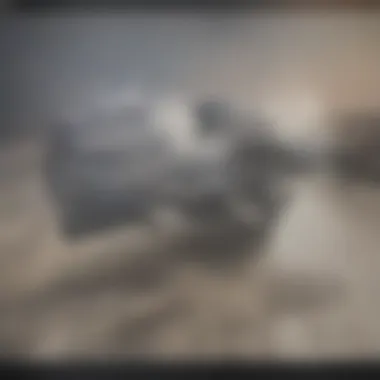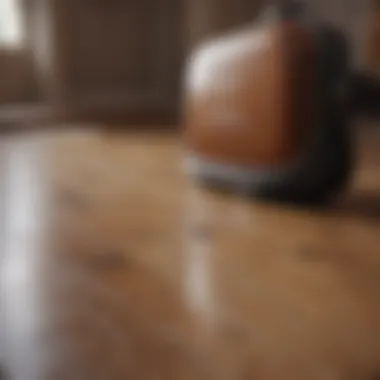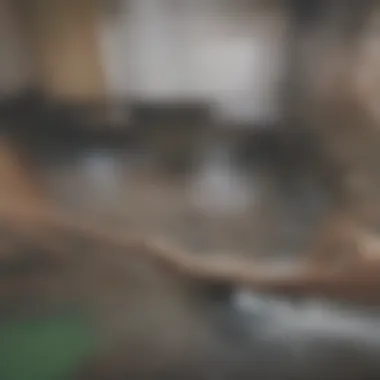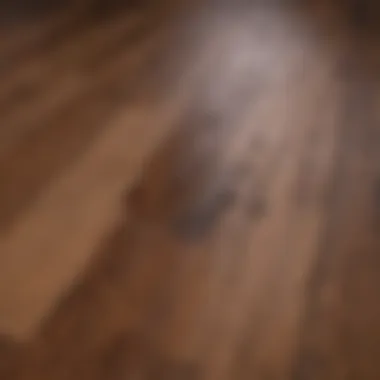Expert Tips for Cleaning Extremely Dirty Hardwood Floors


Intro
Cleaning very dirty hardwood floors can feel like an overwhelming task, particularly if they have seen years of wear and neglect. These floors, often the crowning feature of a home, require a careful balance of cleanliness and care. This guide will delve into thorough methods to breathe life back into your hardwood flooring without sacrificing its structural integrity. We will discuss key cleaning techniques, suitable materials, and preventative measures that can protect your investment.
Understanding the importance of maintaining hardwood floors enhances both the aesthetics and the longevity of your living space. Grime, dirt, and stains can diminish their appeal, leading to a lesser value in both the real estate market and personal enjoyment.
Emphasizing a systematic approach is essential when considering the best way to clean very dirty hardwood floors. This ensures that every aspect of the cleaning process is manageable and effective. Let’s begin with the features of advanced cleaning methods.
Understanding the Nature of Hardwood Flooring
Understanding hardwood flooring is essential for homeowners and those passionate about interior design. Hardwood floors offer visual appeal, durability, and warmth to any space. However, their maintenance can be difficult if one does not comprehend their nature. This section focuses on two key components: types of hardwood floors and common issues faced by hardwood floors.
Types of Hardwood Floors
Hardwood flooring comes in various types, each with distinct characteristics. Generally, there are two main categories: solid hardwood and engineered hardwood.
- Solid Hardwood: Made from a single piece of lumber, solid hardwood is known for its longevity and the ability to be refinished multiple times. It can expand and contract based on humidity, requiring careful installation and acclimatization before laying.
- Engineered Hardwood: This type consists of layers of wood veneer bonded together, offering stability. It is less prone to warping compared to solid hardwood. Engineered hardwood can be installed in areas with higher moisture levels, such as basements.
Both types have their unique advantages and disadvantages, affecting how one should approach cleaning and maintaining them.
Common Issues Faced by Hardwood Floors
Several challenges can arise with hardwood flooring. Understanding these issues is crucial for addressing them properly.
- Scratches and Dents: Everyday activities can lead to minor scratches and deeper dents. These imperfections can detract from the floor’s aesthetic appeal.
- Water Damage: Excessive moisture can cause warping or buckling. This hazard necessitates immediate attention to prevent irreversible damage.
- Stains: Spills can penetrate the finish of the wood if not cleaned promptly. Common culprits include food, drink, and pet accidents.
- Fading: Over time, direct sunlight can fade the wood’s color, leading to uneven shading across the floor.
Proper awareness allows for timely intervention, helping to preserve the beauty and integrity of hardwood floors.
Assessing the Level of Dirt and Stains
Assessing the level of dirt and stains on hardwood floors is a crucial step in the cleaning process. Before embarking on any cleaning mission, understanding what you are dealing with can save time and preserve the quality of the wood. Misjudging the situation can lead to aggressive cleaning that damages the finish or the wood itself. Therefore, this process is about identification. It includes examining the type of dirt present and recognizing specific stains.
Identifying Different Types of Dirt
Dirt on hardwood floors comes in various forms, each demanding a different cleaning approach. Here are the common types you may encounter:
- Dust and Light Debris: This includes everyday dust that settles on the floor, along with pet hair and crumbs.
- Grime: Often a combination of dirt and oils, this is typically found in high-traffic areas and often darkens the wood’s appearance.
- Mud and Soil: This kind of dirt is usually tracked in from outside. It can be challenging, especially when it dries.
- Sticky Residue: Often related to spilled food or drinks, this requires an alternate approach for removal.
By recognizing these types of dirt, homeowners can choose the right tools and techniques for their specific problem, therefore streamlining the cleaning process.
Understanding Stain Composition
Stains can vary widely in their composition, which influences how they should be treated. Understanding the nature of stains can help in selecting the correct cleaning solutions. Some common types of stains include:
- Water Stains: These are often caused by spills or moisture and may cause discoloration.
- Oil-Based Stains: These are tougher to remove since they penetrate deep into the wood. Examples include grease from food or oily liquids.
- Dye Stains: These can result from colored beverages or inks and may require specific solutions for removal.
Getting to know the composition of the stains can guide the homeowner in applying suitable and effective cleaning methods without risking further damage to the surface.
Important Tip: Always test any cleaning solution in an inconspicuous area first before applying it to the entire stain.
In sum, carefully assessing the level of dirt and stains prepares you to tackle the cleaning job effectively. It enables tailor-made solutions that ultimately protect the wood’s integrity and appearance.


Gathering the Necessary Cleaning Supplies
Cleaning very dirty hardwood floors demands careful preparation. Gathering the necessary cleaning supplies significantly influences the success of your cleaning efforts. Having the right tools and solutions on hand ensures that the process is efficient while maintaining the integrity of the wood. Furthermore, it can prevent potential damage that might occur when using inappropriate products. By investing some time in gathering supplies, you can make the cleaning experience less stressful and more effective.
Essential Tools for Cleaning
To effectively clean hardwood floors, certain tools are essential. Having a proper toolkit can make all the difference in not just cleaning, but also in safeguarding the surfaces.
- Soft-bristle Broom: This is critical for dry dusting. It effectively collects dust and dirt without scratching the wood surface.
- Microfiber Mop: Known for its ability to trap dirt and debris, this tool is ideal for wet mopping. It is gentle on wood but effective in cleaning.
- Bucket: A sturdy bucket is needed to mix your cleaning solutions and carry water around.
- Vacuum Cleaner: Using a vacuum with a hardwood floor attachment helps remove particles that a broom might miss. Look for one specifically designed for hardwood or with a soft bristle brush.
- Scrub Brush: Some stubborn spots may require a scrub brush with soft bristles. It is effective for gentle scrubbing while not harming the finish of your floor.
- Cloths: Soft, non-abrasive cloths are essential for drying and buffing the floors for any remaining moisture after mopping.
Having all these tools on hand will streamline the cleaning process, making it much more manageable.
Selecting Appropriate Cleaning Solutions
Choosing the right cleaning solutions is just as important as having the right tools. Various types of cleaning agents can impact the floor's finish and longevity.
- pH-Neutral Cleaners: These cleaners are effective for regular cleaning and do not harm the wood's natural finish. They maintain the protective sealants present on finished floors.
- Vinegar Solution: Mixing vinegar with water can provide an effective, natural cleaning solution. However, it should be heavily diluted to avoid damaging the wood. Generally, a mixture of 1 cup of vinegar per gallon of water works well.
- Commercial Wood Cleaners: Many brands like Bona and Murphy's Oil Soap offer commercial wood floor cleaning solutions. These are specifically formulated for hardwood floors and will ensure a clean, residue-free surface.
- Avoid Ammonia and Oil-based Products: These can lead to a buildup of residue and damage the flooring over time.
Choosing properly suited cleaning solutions is crucial in maintaining not just cleanliness but also the aesthetic appeal of the hardwood surfaces.
Preparing the Area for Cleaning
Preparing the area for cleaning is a crucial step in the process of restoring dirty hardwood floors. A well-prepared space not only allows for more effective cleaning but also helps to prevent damage to the flooring and ensures that all areas are thoroughly addressed.
Key Elements of Preparation
Before diving into the cleaning itself, it is essential to take stock of the area's condition and what needs to be done. Here are some considerations:
- Furniture and Obstructions: Clearing the floor of furniture and other obstructions ensures that every square inch of the flooring can be reached. Removing these items reduces the risk of damage to both the furniture and the floors. It also allows for a more efficient cleaning process as you can work swiftly without needing to move things around constantly.
- Assessing Risk Areas: Look for potential hazards that might impede the cleaning process. Items like vases, picture frames, and electronic devices should be either removed or securely relocated. This includes checking for any uneven surfaces, loose boards, or protruding nails that could cause accidents during cleaning.
- Safety Precautions: It's essential to consider safety when preparing the area. If any cleaning solutions will be used, ensure proper ventilation. This might involve opening windows or using fans to circulate air. Ensuring that children and pets are kept away from the area during cleaning is also prudent, as cleaning products can be hazardous.
Benefits of Proper Preparation
The importance of preparing the area cannot be overstated. Here are some advantages:
- Efficient Cleaning Process: An unobstructed floor makes it easier to assess the surface condition and allows for quicker cleaning.
- Minimizes Damage Risk: Taking the time to clear the area reduces the chances of scratching or damaging your hardwood floors or items in the space.
- Impact on Results: Preparing properly not only improves the overall efficiency but also enhances the final outcome, leaving you with visually restored floors.
Clearing the Floor
Clearing the floor sets the stage for successful cleaning. Start by removing all furniture, rugs, and any decor that may be on the floor. This involves not just lifting heavier items but also clearing small odds and ends that might be overlooked.
It is beneficial to take this step systematically: begin in one corner of the room and move around in a clockwise or counterclockwise direction. This method ensures nothing is missed and provides a sense of accomplishment as you see sections of the area becoming cleaner.
Where large items cannot be easily moved, consider using furniture sliders to prevent scratches on the floor as you shift them slightly. Once everything is gone, a quick sweep or dusting will help remove particulates that would otherwise interfere with deeper cleaning techniques.
Evaluating Flooring Condition
Once the area is clear, evaluating the condition of the flooring becomes essential. This includes assessing for scratches, dents, and other forms of damage. Look for any discoloration that may indicate deeper stains or wear.
Pay attention to:
- Surface Scratches: Notice how deep they are and determine if they require special attention during your clean.
- Stains: Identify any stubborn stains that might need targeted treatment instead of general cleaning solutions.
- Water Damage: Inspect for areas where moisture may have compromised the integrity of the wood. Signs may include swelling, warping, or discoloration.
Knowing the condition of your flooring before starting the cleaning process will help guide you in selecting the appropriate cleaning supplies and techniques to restore your hardwood to its best condition.
Properly preparing the area not only maximizes cleaning efficiency but also significantly enhances the effectiveness of restoration efforts.


Initial Cleaning Techniques
The initial stage of cleaning very dirty hardwood floors is crucial. It sets the foundation for further interventions. Without proper preliminary techniques, ingrained dirt may persist, making subsequent efforts less effective. This section discusses the importance of dry dusting and sweeping, as well as wet mopping, both essential to revitalizing the floors.
Dry Dusting and Sweeping
Dry dusting and sweeping is the first step in cleaning hardwood floors. This process removes loose dirt and debris. Using a soft-bristled broom or a microfiber dust mop is ideal. A vacuum cleaner can also be effective, but one must ensure it has a hard floor setting to prevent damage.
Benefits of dry dusting include:
- Preventing scratches: Loose dirt can act as an abrasive. If left unaddressed, it may scratch the floor surface during mopping.
- Easier cleaning: Removing debris first makes subsequent cleaning quicker and more efficient.
Before starting, it is wise to clear the floor of furniture and rugs. This progress allows for complete access and thorough cleaning, maximizing results.
Wet Mopping with Care
After dry dusting, wet mopping is the next vital step. While cleaning floors, it is critical to choose the correct cleaning solution and amount of water. Hardwood is sensitive to moisture, so excessive water can warp the wood.
To wet mop effectively, follow these guidelines:
- Use a damp mop, not a soaking one. A microfiber mop head is preferred, as it holds water well without soaking the floor.
- Select a wood-safe cleaner. It is essential to read labels and avoid harsh chemicals that can damage finishes.
- Mop in the direction of the wood grain. This method ensures each stroke aligns with the natural flow of the floor, reducing potential wear.
"Always remember, moderation is the key. Too much moisture can harm the floor, while too little may not yield desired results."
Addressing Stubborn Stains
Cleaning hardwood floors involves understanding and addressing stubborn stains. These stains can significantly detract from the appearance of your flooring and, if left unattended, can cause permanent damage. Addressing stubborn stains is crucial for both aesthetic and protective reasons. The method employed can either enhance or harm the floor surface, thus making it essential to choose appropriate techniques and products.
Targeting Specific Stains
Certain stains require specific treatments. For example, pet urine requires immediate attention to prevent it from soaking into the wood and causing discoloration. To treat this, start by blotting the area with paper towels to absorb the moisture. Next, mix equal parts of white vinegar and water to gently clean the stain. Another common issue is food stains, like red wine or juice. For these, a combination of baking soda and water can be effective, creating a paste that can lift the stain without scratching the floor.
In addition, grease stains can be particularly stubborn. They demand a slightly different approach. Applying a small amount of dish soap mixed with warm water can help break down the grease. Use a soft cloth to dab at the stain without aggressively scrubbing.
Creating a Gentle Scrub Solution
For tougher stains, a gentle scrub solution can be very beneficial. Ingredients like baking soda, vinegar, and water are not only effective but also non-toxic. Begin with a basic ratio of three parts baking soda to one part water. This forms a paste that can be used to carefully scrub the stained area with a soft-bristle brush.
You may also consider using castile soap blending it with water for added effectiveness. It is gentle enough for hardwood surfaces and leaves no residue. Just ensure to rinse the floor with water afterward to eliminate any soap residue, which could create future adhesion issues with dirt.
"The key is to always test any cleaning solution on a small, inconspicuous area first to ensure it won't damage the finish of the floor."
Utilizing this method of addressing these stains not only revives the floor's appearance but also aids in the maintenance of its longevity. An understanding of specific stains, accompanied by appropriate cleaning solutions, ensures successful and effective overall cleaning.
Advanced Cleaning Methods
Advanced cleaning methods are essential for treating very dirty hardwood floors. These methods go beyond basic cleaning, addressing long-standing grime and stubborn stains effectively. When floors have accumulated significant dirt, typical cleaning techniques may prove insufficient. Therefore, incorporating advanced approaches can revitalize the appearance of your wood flooring while also safeguarding its natural beauty.
Employing specialized tools and techniques not only enhances cleanliness but also preserves the integrity of the hardwood. Many homeowners may not realize that aggressive scrubbing or unsuitable cleaning agents can cause damage. Thus, understanding these methods can lead to better results and extended life for your floors.
Using a Steam Cleaner


Steam cleaners offer an efficient way to clean hardwood floors, and they are especially valuable when dealing with heavy dirt build-up. Using high temperatures, steam effectively loosens grime. This heat is made without the use of harsh chemicals, making it a safer alternative for families or individuals concerned about residue. However, it is important to check if your flooring is suitable for steam cleaning. Some finishes may be sensitive to moisture and heat.
When using a steam cleaner:
- Prepare the floor: Remove all furniture and items from the area to avoid obstacles.
- Vacuum beforehand: Ensure the surface is free from loose dirt and debris to prevent scratching.
- Test in an inconspicuous area: Apply the steam in a small spot first to ensure no adverse reactions occur.
Steam cleaning can not only provide a thorough clean but also help to sanitize surfaces, reducing potential allergens. It is a method appreciated for its efficiency, but attention should be taken on proper use to avoid any potential damage to the wood.
Implementing a Buffer for Gloss and Shine
Using a floor buffer can enhance the shine of hardwood floors effectively. If your wood floors are looking dull after a deep clean, a buffer can restore their luster. Buffers work by polishing the surface, removing fine scratches, and leveling the finish, which leads to a more uniform appearance.
To buffer hardwood floors:
- Choose the right pad: Different pads serve various purposes, so select one designed for your specific floor type.
- Follow the instructions of the buffer: It's essential to operate the equipment correctly. Every buffer may operate slightly differently.
- Do a thorough clean before buffing: Remove dust and dirt to avoid trapping particles that can scratch the finish during buffing.
After buffing, the floor will have a renewed vibrancy. This method is generally safe but should be used with caution. Too much buffing can dull the finish over time, rather than enhance it.
"Proper maintenance and advanced care can significantly extend the life of your hardwood floors while maintaining their exquisite appearance."
Combining these advanced cleaning methods ensures your hardwood flooring looks its best while retaining its essential properties. Knowing when and how to apply steam cleaning or buffing will give what you need for much cleaner and shining surfaces.
Post-Cleaning Care
After the intense efforts of cleaning hardwood floors, post-cleaning care becomes an essential consideration. It ensures that the floors not only retain their cleaned state but also increases their longevity. Implementing a proper follow-up routine can protect against future damage while enhancing the floor's aesthetic appeal. Addressing the post-cleaning phase is crucial for sustaining the clarity and vitality of hardwood surfaces.
Evaluating Results and Making Adjustments
Once cleaning is complete, assessing the results allows homeowners to determine the effectiveness of the methods used. This evaluation can include visually inspecting the floors for any missed spots or remaining stains. It is also wise to throw in a few practical tests, like checking if any damp patches remain after drying, or if the floor still feels sticky to the touch. Adjustments can be made based on this evaluation. If certain areas did not respond well to cleaning, applying specific cleaning solutions designed for those stains can be beneficial.
It is vital to document findings and choices for future reference. Homeowners might find it useful to take photos of the floor before and after the cleaning session. This documentation helps in creating a tailored cleaning regimen to address persistent issues moving forward.
Sealing and Protecting the Surface
After cleaning and ensuring that the floor looks its best, sealing the hardwood is a protective measure that should not be overlooked. Applying a sealant can create a barrier against dirt, moisture, and even scuff marks. It's important to select a high-quality sealant appropriate for the specific type of wood flooring. Consultation with a flooring expert can aid in choosing the right product; some popular options include polyurethane or wax-based sealers.
Applying the sealant involves cleaning the floor thoroughly, allowing it to dry completely, and then evenly spreading the sealing agent using a clean mop or applicator. Following the manufacturer's instructions is critical to achieve the best results.
Establishing a Maintenance Routine
Establishing a regular maintenance routine is essential for the longevity and aesthetic appeal of hardwood floors. It allows homeowners to manage the wear and tear that comes with daily use and environmental factors. Without consistent upkeep, dirt and grime can accumulate, leading to deeper staining and potential damage to the wood finish. A systematic approach not only preserves the floor's beauty but also saves time and money in the long run.
A maintenance routine involves scheduling regular cleaning and inspections to catch any issues early. This proactive strategy enables homeowners to adapt cleaning techniques based on the specific conditions of their hardwood surfaces. It is crucial to balance thorough cleaning with protective measures to prevent scratch and other potential damage. This section elaborates on two key components: a regular cleaning schedule, and preventive measures against dirt accumulation.
Regular Cleaning Schedule
Creating a consistent cleaning schedule is vital. Depending on the foot traffic and usage of your space, cleaning routines may vary. Here are some guidelines to consider:
- Daily Cleaning: Sweep or dust mop to remove loose dirt and debris. This prevents grinding dirt into the floor and minimizes scratches.
- Weekly Cleaning: Mop using a damp cloth or microfiber mop. Ensure no water pools, as excessive moisture can harm the wood.
- Monthly Cleaning: A more thorough clean, using specialized hardwood floor cleaners, is recommended. This helps in removing built-up residues that regular cleaning might miss.
- Seasonal Inspections: Inspect for any scratches, dents, or signs of wear. Early detection allows for quicker repairs, minimizing damage.
Integrating these practices into your routine will keep your hardwood floors looking their best and ensure they respond well to deeper cleaning when necessary.
Preventive Measures Against Dirt Accumulation
Taking preventive measures is an effective strategy to facilitate easier cleaning and maintenance. Implementing a few simple steps can significantly decrease the amount of dirt that accumulates over time:
- Area Rugs and Mats: Placing rugs at entryways can trap dirt and moisture before it reaches your hardwood floors. Consider using mats that are easy to clean or replace.
- Furniture Pads: Attach pads under furniture legs to avoid scratches and dents. These pads create a barrier that reduces wear from moving furniture.
- Regular Shoe Policies: Encourage family members and guests to remove shoes before entering the hardwood areas. This simple act can prevent bringing in excessive dirt and grime.
- Humidity Control: Maintain appropriate humidity levels in your home, ideally between 30% and 50%. Excessive humidity can lead to warping or swelling of the wood.
By implementing these preventive strategies alongside a regular cleaning schedule, homeowners will significantly reduce the need for intensive cleaning sessions, prolonging the life of their hardwood floors.







